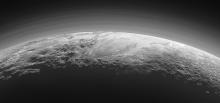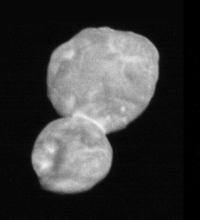Listen to today's episode of StarDate on the web the same day it airs in high-quality streaming audio without any extra ads or announcements. Choose a $8 one-month pass, or listen every day for a year for just $30.
You are here
Deep Ocean
An ocean of liquid water might lurk below the icy crust of Pluto. And it might have been around since the little planet was born.
Scientists have based those conclusions in part on Pluto’s most prominent feature — a heart-shaped basin called Sputnik Planitia. It was discovered by the New Horizons spacecraft, which flew past Pluto six years ago.
The basin probably formed billions of years ago, when a giant asteroid hit the young world. The hole gouged by the collision most likely filled with water from the ocean, then was coated with ice when some of the atmosphere froze atop it.
New Horizons discovered a jumbled landscape on the other side of Pluto — a region of big ridges and cracks. The area might have been mangled by vibrations from the impact moving all the way through Pluto.
But a study suggests that to form such a large area of mangled terrain, Pluto must have had a deep but hidden ocean at the time of the impact. And the only way to keep the ocean from freezing was for Pluto to have formed quickly — in less than 30,000 years. The fast build-up would have made Pluto’s interior hot. As the heat worked its way outward, it would have kept the ocean warm and wet.
The ocean has undergone many changes over the eons. It’s not as deep now, and it’s probably slushy. But it appears to still be there — helping make Pluto a dynamic little world.
Pluto is at its best for the year this week, and we’ll talk about that tomorrow.
Script by Damond Benningfield





